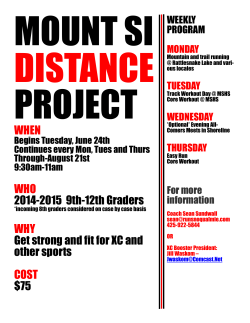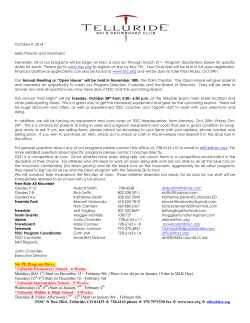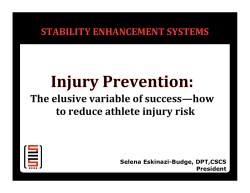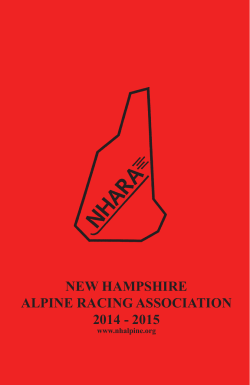
Document 301479
SNSC 2013-‐2014 Parent Manual Welcome! The Very Basics Personal Responsibility Organization Basics Season Schedule USSA Junior Nationals Communications Development Pipeline School vs. Club skiing Roles of Parent vs. Coaches Typical Race Day Schedule Page 2 Page 3 Page 5 Page 6 Page 7 Page 8 Page 9 Page 10 Page 12 Page 13 Page 14 The Training Bag Nutrition Gear Guidelines The World of XC Skiing Useful Websites Page 15 Page 16 Page 17 Page 18 Page 21 www.SummitNordicSkiClub.org www.facebook.com/SummitNordicSC 1 Welcome! Hello and thank you for being a part of the Summit Nordic Ski Club. Your son or daughter has chosen to be part of something that will have a positive effect on his/her entire life. We at SNSC believe this fully. Sport is not “just a game.” It is a metaphor for life. Through the skills young student-‐athletes gain in striving to be their best at cross country skiing, lessons are learned that will lead to success in all avenues of life. “We are what we repeatedly do. Excellence, then, is not an act, but a habit.” - Aristotle 2 The Very Basics Nordic skiing is an umbrella term commonly used to describe cross country (XC) skiing. Technically, Nordic skiing includes ski jumping and Nordic Combined (ski jumping AND XC-‐skiing). Cross country skiing as a stand alone sport has two techniques, and all athletes compete in both. “Classic” (above) skiing is a movement very similar to running or skinning, but much more dynamic and faster than either. 3 “Freestyle” or “skate” skiing is more similar to ice skating, rollerblading, or getting to the lift on alpine skis. Different equipment is used for both techniques. Classic skiing uses longer softer skis, shorter poles, and softer boots. Skating uses shorter stiffer skis, longer poles, and stiffer, more supportive boots. For young beginner skiers, using combination (“Combi”) skis and boots is advisable. Once athletes are U12’s (see page 4 for age groups), they should have separate classic and skate skis, but Combi boots are still ok. By the time they are U14’s, they should have both training and racing skis for both techniques. 4 Developing Personal Responsibility One of the important life lessons that the SNSC coaching staff strives to drive home is personal responsibility. We believe that the athletes need to be a driving force in their own athletic development and to take ownership in the process as much as possible. It is for this reason that day to day communication is done through the athletes, not the parents. By giving the athletes the responsibility to translate information coming from coaches into logistical decisions made by the athlete/parents, they learn to manage time and communication. Setting their own alarm clocks/waking themselves up for early training is very important for older athletes. Learning that it is their own decision to sleep in or get up and train is important for their future. In addition to waking up on their own, transitioning to packing their own training bag (see page 13) is also a step towards athlete accountability that we would like to see. While it’s obviously a bit much for an elementary school athlete to do this on his/her own, by the time an athlete is in high school, he/she should be nearly 100% self-‐sufficient 5 Organization Basics The Summit Nordic Ski Club (SNSC) is a member of the Rocky Mountain Nordic (RMN) division of the United States Ski and Snowboard Association (USSA). RMN-‐ Rocky Mountain Nordic is the governing body responsible for cross country skiing in Colorado. RMN determines the JN’s qualification policies and takes the team to JN’s. USSA-‐ The United States Ski and Snowboard Association is the governing body responsible for cross country skiing in the US. The USSA organizes and runs Junior Nationals. The USSA also ranks skiers at USSA sanctioned races and makes a points list which is used to determine everything from start spots at JN’s, to spots on the Olympic Team. The USSA stipulates that age groups are broken up by year of birth. Age groups for the 2013-‐2014 season are: USSA Age Group * U8 U10 U12 U14 U16 U18 U20 U23 Senior Birth Years 2006-2007 2004-2005 2002-2003 2000-2001 1998-1999 1996-1997 1994-1995 1990-1993 1993- Race distances 1K 1K 3K 3K 5K 5/10K 5/10/15K 5-50K 5-50K The season is based around four (4) USSA sanctioned RMN Junior National’s Qualifier race weekends. These weekends will have 2 races in two days. The culmination of the season is the USSA Junior National Championship (“JN’s”). The 2014 JN’s will be in Stowe, VT on March 11-‐16. *As of August 2013, the USSA has changed from the old OJ, J1, J2, etc. age groups to the more universal “U” system. 6 Grouping training programs by age group in Summit County presents a problem, as school release times are different. For that reason, the separation between Prep and Devo teams is based on grade, while the separation between Devo and Comp is based on age group. SNSC Comp Team: U20, U18, U16 SNSC Devo Team: U14, most U12’s (All 6th and 7th graders are Devos). SNSC Prep Team: Some U12’s (All 5th graders are Preps). Season Schedule SNSC Schedule Of Events 2013-‐2014 Date Sept 27 -‐ 29, 2013 Oct 12 -‐ 13, 2013 Event Location Comments USSA National Coaches Educational Symposium RMN Select Teams Fall Camp & Fall RMN Meeting Aspen, CO Nov 23 -‐ 30, 2013 West Yellowstone, MT Training & Super Tour Races Nov 29 -‐-‐ Full Sprint F Nov 30 -‐-‐ 10 / 15 Interval Start F Dec 7 & 8, 2013 RMN NRL Grand Mesa, CO Dec 7 -‐-‐ 10 / 5km Interval F Dec 8 -‐-‐ 10 / 5km Interval C Dec 21 & 22, 2014 RMN JNQ Crested Butte, CO Jan 31 -‐ Feb 1, 2014 Feb 7 & 8, 2014 Dec 21 -‐-‐ Sprint C Dec 22 -‐-‐ 5km F Jan 31 -‐-‐ 5 / 10km Interval Start C RMN JNQ & RMISA CU Invite Steamboat Springs CO Feb 1 -‐ -‐ 1 5 / 20km Mass F Juniors 5 / 10km Mass F Feb 7 -‐-‐ Sprint C Super Qualifier & RMN JNQ Soldier Hollow, UT Feb 8 -‐-‐ 5 / 10 / 15km Mass Start F Feb 21 -‐ 22, 2014 RMN JNQ & RMISA DU Invite Minturn, CO Maloit Park Naming JN Team U14 and Younger RMN Championships Mar 3 -‐ 8, 2014 Junior National Championships, Stowe, VT Feb 21 -‐-‐ 5 / 10km Interval Start C Feb 22 -‐-‐ 15 / 20km Mass F Juniors 5 / 10km Mass F Mar 3 -‐-‐ 5 / 10km C Interval Start Mar 5 -‐-‐ Sprint C Mar 7 -‐-‐ 5 / 10 / 15km Mass Start F Mar 8 -‐-‐ Relays -‐-‐ 3km F Races in Bold are JN qualifiers. 7 USSA Junior National Championships SNSC Qualifiers to 2011 USSA JN’s. Qualification for JN’s: Only U16 , U18, and U20 skiers qualify for JN’s. However, there is a precedent for 2nd year U14 skiers to “race up” in qualifying races and qualify as a U16. Best 4 race points added. Top 9 U16’s, top 12 U18/U20’s. Points for JNQ’s. 1st place: 100pts nd 2 place: 80pts 3rd place: 60pts th 4 place: 50pts 5th place: 45pts th 6 place: 40pts 7th place: 36pts th 8 place: 32pts 9th place: 29pts th 10 place: 26pts etc. For more info, please see the Rocky Mountain Nordic Website: http://www.rmnordic.org/ 8 Pre-‐Qualifying for JN’s Be one of the top 20 Junior (under 20) athletes at the USSA Senior National Championships in January. Junior Nationals Upon qualifying for JN’s, athletes are responsible for the costs associated with the trip. RMN takes 14 coaches and upwards of 50 athletes. Costs are usually $1500-‐$2500. USSA membership is necessary to qualify. Communications All major communications through the club are carried out via email PLEASE MAKE SURE WE HAVE YOUR CURRENT EMAIL ADDRESS!! Comp Team: For the Comp Team, coaches strive to communicate directly with the athletes. Scheduling/events are sent out via email and short term changes are communicated via text message. Devo and Prep Teams: For the Devo and Prep Teams, communication happens though emails to the parents and occasional phone calls. Training Plans: Available on the website under Programs -‐> Training -‐> Training Schedules Updated every two weeks. Training Log: Available on the website under Programs -‐> Training -‐> Training Log Racing: All athletes will need to confirm that they are racing two (2) weeks before a racing weekend to be able to race. 9 Summit Nordic Ski Club Pipeline SNSC and Partners Bill Koch League Ages: U8, U10 Purpose: Learn to ski Summer: Active lifestyle Winter: 2 sessions/week Racing: None SNSC Prepatory “Prep” Team Ages: U10, U12 Purpose: Athletic fundamentals. Introduction to racing Summer: Active lifestyle Winter: 2-‐3 sessions/week Racing: 2-‐3 times per winter 10 SNSC Development “Devo” Team Ages: U12, U14 Purpose: Learning to prepare for sport. “Training” is introduced. Learn to race. Summer: 3-‐5 sessions/week Winter: 5-‐7 sessions/week Racing: 8-‐10 races per winter SNSC Competition “Comp” Team Ages: U16, U18, U20 Purpose: Performance. Athletes train to race. Summer: 7-‐10 sessions/week Winter: 7-‐10 sessions/week Racing: 10-‐15 races per winter Mike Vigers Tucker McCrery Charlie Von Thaden BNJRT SNSC SSWSC RMN 2011 USA U20 National Championship relay team 11 School vs. Club Skiing The title above is misleading. There should not be a “versus.” Both school and club skiing have very different and useful roles in the education and development of young cross country skiers. The role of school skiing School skiing is perfect for athletes who are new to the sport or those who are comfortable with their current level of commitment to the sport. If an athlete wants to ski because he/she loves to ski but doesn’t want to devote a lot of time to it, school skiing is the perfect option. School skiing is for athletes who want to be life long skiers, but don’t want to compete after high school. The role of club skiing Club skiing is for those athletes who strive to get everything possible out of cross country skiing. It is for those athletes who want to spend more time, work harder, and get more out of the sport. From club skiing, athletes can go on to ski in college, the U.S. Ski Team, and even the Olympics. The relationship between school and club skiing in Summit County We at SNSC believe that every athlete has an optimal level of commitment to cross country skiing. If they are heavily invested in afterschool academic/social clubs, but still love to ski, then school skiing is perfect for them. If they want to devote more time to be very successful in cross country skiing, the club is probably a better choice. The vast majority of SNSC athletes also ski high school, as a way to get more camaraderie, training, and race starts. 12 Roles of Coaches vs. Parents Coaches and parents have very different roles in the successful development of young student athletes. Please read-‐ “Parenting the young skier” document (written by former SNSC Head Coach Justin Easter) on the SNSC website. The role of the coach (Bad Cop/Good Cop): 1. Help athletes with goal setting process 2. Write training plans 3. Wax skis 4. Critique races 5. Go back to 1. The role of the parent (ONLY Good Cop): Support the athlete emotionally, financially, and transportationally (Yes I’m aware that isn’t a word). PERIOD. Coach roles are EXCLUSIVE of parents. As are discussions of those 4 subjects with athletes. For example: Do not critique your child's race. Ever. If your athlete has a great race, your response should be: "Great race! Want a hot chocolate/ice cream?" If your athlete has a bad race, your response should be: "Great race! Want a hot chocolate/ice cream?" Don’t ask your child about wax. Don’t ask if they have seen competitor X. Don’t ask if they are hungry/thirsty/need to pee. Actually, it’s best not to speak to your child at the venue before the race other than to say, "You're going to do great honey, have fun out there!" Your job on race day is to feed your child, deliver your child to the venue with all the appropriate items at the appointed time. Any additional discussion will usually turn them into a driveling mess of nerves, which is rather unproductive. If you have questions/comments/concerns about any of those issues PLEASE TALK TO THE COACHES! We have a wide open door policy, and love to talk about any concerns, but it should primarily be a discussion between coach and parents, as well as between parents and athletes. The only exception to our open door policy is on race mornings. As coaches, we strive to educate and answer questions whenever possible, but with time constraints on races days, it will be much more effective to approach us after the race, or to text or email the coaching staff to set up an appointment later. 13 Typical Race Day Schedule: 3:00 pre-‐race: 1:30 pre-‐race: 1:00 pre-‐race: Pre-‐Warmup Breakfast. Arrive at venue, get bib and start time Begin warm-‐up Warmup Warmup is performed in race bottoms, ski pants, long underwear top, and warmup jacket, NOT puffy. If it is very cold, a thin vest can be added. 1:00 pre-‐race: At least 20 minutes of easy skiing focused on technique 0:30 pre-‐race: 2 minutes hard, 3 minutes easy, 1 minute hardER, 2 minutes easy, 1 minute hardEST. 0:20 pre-‐race: 5 minutes easy ski 0:15 pre-‐race: Test race skis. Tests should be 5X 15 seconds as fast as you can with 45 seconds in between. 0:10 pre-‐race: Report back to coaches about skis. Change into dry long-‐underwear top, race top, and bib. 0:05 pre-‐race: At the start, with bib and race skis, staying moving. RACE! :05 post-‐race: Change into dry long underwear top and warmup jacket, ski for 15-‐20 minutes. :30 post race: Changed into totally dry clothing, this INCLUDES underwear, socks, and sports bras. Must have had a snack, and at least 8 ounces of water 14 The Training Bag Every morning before school, you should pack your training bag. In it, you should have: 1. Training clothes-‐You should have ALL of this every day, even if it’s really warm out. a. Windbriefs/Sports bra b. Long underwear c. Tights d. Ski Pants e. Socks f. Training jacket g. Hat h. Gloves i. Sunglasses j. HR monitor (Or at least a watch) k. Water belt l. Ski boots 2. Stuff for after a. Dry shirt b. Dry sports bra c. Heavy jacket d. Water bottle (different from water belt) e. Snack • 300 calories, 75% carbs, 25% protein f. Dry hat 15 Nutrition: For the junior athlete, nutrition is critical. Throughout their training, racing, school, and life, young athletes are growing, adapting, breaking, and repairing constantly. It is essential for both their short and long term health and performance that diet/nutrition is considered, discussed, and acted upon. Proper, sustainable healthy eating is based in moderation and common sense. The Michael Pollen approach: “Eat food. Not too much. Mostly plants,” is a very simple way to approach the topic of healthy eating. 1. Eat food. The closer that food is to coming from the ground/animal, the better it is for your body. The more that the “food” has been processed/ground/mixed/preserved, the less nutrients it contains. A good tactic it to eat food based on what it HAS, and not what it DOESN’T have. Steer clear of “low fat,” or “diet” food, as they often remove nutrients, and don’t taste very good. 2. Mostly plants Plants should comprise a bulk of your athletes intake, because they are very nutrient rich. Different colors mean different nutrients, so a food rich in colors (NOT food coloring) means a food rich in nutrients. The fresher the better. When you can, jar, dehydrate, freeze, etc. a plant, it loses some of it’s nutrients. 3. Not too much For a young athlete, this isn’t really an issue, but efforts should be made to eat lots of small meals instead of 1-‐2 giant meals a day. Here are some basic guidelines on the timing of food: 1. Eat within 30 minutes of waking. 2. Snack before main meals. 3. Snack before you work out 4. Eat during your workout 5. Eat after your workout 16 Gear for a Cross Country Skier Listed in order of importance 1. Skis: In a perfect world all athletes on the Comp Team should have 6 pairs of skis (classic and skate for each of the categories below), only 2 of which need to be “good” skis. • Race skis • As high quality as possible, fit is paramount. • Practice/warmup skis • Quality is good but not necessary, MUST FIT PROPERLY and ski like the athlete’s race skis. Scratches are ok. • Rock skis • DIFFERENT from the above skis, low quality, fit is important but secondary to having something that can be beaten up. 2. Poles: 1 pair classic, 1 pair skate • Should have sharp rollerski tips for the summer, and baskets for the winter • Velcro straps, no biathlon straps 3. Boots: • Fit is primary, “quality” (cost) is secondary. Age of boots is important. Having two pairs is essential for U16 and up. 4. Water system • Water bottle holder • Pro: Can use any bike bottle • Con: nozzles can freeze, bottles can fall out/get lost • Waterbelt • Pro: Holds more water, doesn’t freeze • Con: More expensive 5. Heart Rate Monitor • • • Should display Current HR and time at the same time Should have the ability to record splits Should have the ability to record average heart rate 6. Rollerskis • Skate is first priority, newer is better 17 The World Of Skiing-‐Where can YOU go? Racing series’ Domestic Intramural/ Interscholastic Middle School-‐ Good introduction to the sport. CHSAA High School-‐ Great place to learn, not really any chance for going on past high school competitively. Rocky Mountain Nordic (RMN)-‐ “Club.” Can qualify you for Junior Nationals USCSA Collegiate Skiing-‐ Collegiate club system. Not very competitive, but an excellent way to stay in the sport part-‐time. Most teams will take any skier, no scholarships. NCAA Collegiate Skiing-‐ Extremely competitive. Basically won’t consider an athlete unless they’ve been to Jr. Nationals. Scholarships available. National Rankings List Races (NRL’s)-‐ Can improve your USSA points The National Rankings list is a list based on USSA Points. USSA points are based on how far you finish behind the top 5 racers in a race, taking into consideration how strong the field is at those races. The lower the points the better. SuperTour-‐ There is a Supertour overall points list, but since bonus prize money has been eliminated, this is mostly about USSA points Continental Cup-‐ Races in both USA and Canada, not very many of them. 18 Europe Scandinavian (Scando) Cup-‐ This is a USSA sponsored trip to do some races in Europe. To qualify, you must finish in the top 6 U18’s at Senior Nationals. OPA Cup-‐ Development series just below the World Cup. No real qualification criteria, usually USST B Team will go. World Cup-‐ The BEST. Must have certain FIS points (Same idea as USSA points, but global) to be eligible, qualify by being on the USST, Racing Championships CHSAA State Championships-‐ To Qualify you must finish in the top half of a CHSAA qualifier, and have two skate, and two classic races. Junior Nationals (JN’s) To Qualify, you must finish the year in the top 9 (U16’s), or the top 12 (U18/U20’s) in the RMN ranking list. Senior Nationals-‐ No qualifying standards, but this is where you qualify for Scando Cup, any World Champs (Junior, U23, Seniors), and usually the Olympics. Junior World Championships-‐ To Qualify, you must finish in the top 5 Juniors at the Senior National Championships. U23 World Championships -‐ To Qualify, you must finish in the top 5 U23 athletes at the Senior National Championships. World Championships -‐ Qualify through Senior Nationals, no set number Olympic Games-‐ Qualify through Senior Nationals, no set number 19 Camps/ Teams RMN Select Team – Top 6 U18/U20’s, plus top 3 U16’s Regional Elite Group (REG) – Top 15 Juniors in the Western Region National U16 Camp – Top 20 U16’s in the country National Elite Group (NEG) – Top 10 Juniors in the country National Training Group (NTG) – 25 Juniors, named by the US Ski Team US Ski Team (USST) – Some objective, some subjective criteria, no set number. 20 The SNSC Board of Directors SNSC Board has six members and one skier representative. The Board sets the budget, hires coaches, fundraises, and carries out the operations of the club. Meeting minutes and Board policies are posted on the SNSC website. There is always room for a parent who would like to become more involved in making SNSC the best club it can be! Useful Websites Education/Information www.summitnordicskiclub.org www.rmnordic.org www.ussa.org www.FasterSkier.com Equipment www.skinnyski.com www.bouldernordicsport.com www.Gearwest.com 21
© Copyright 2025















